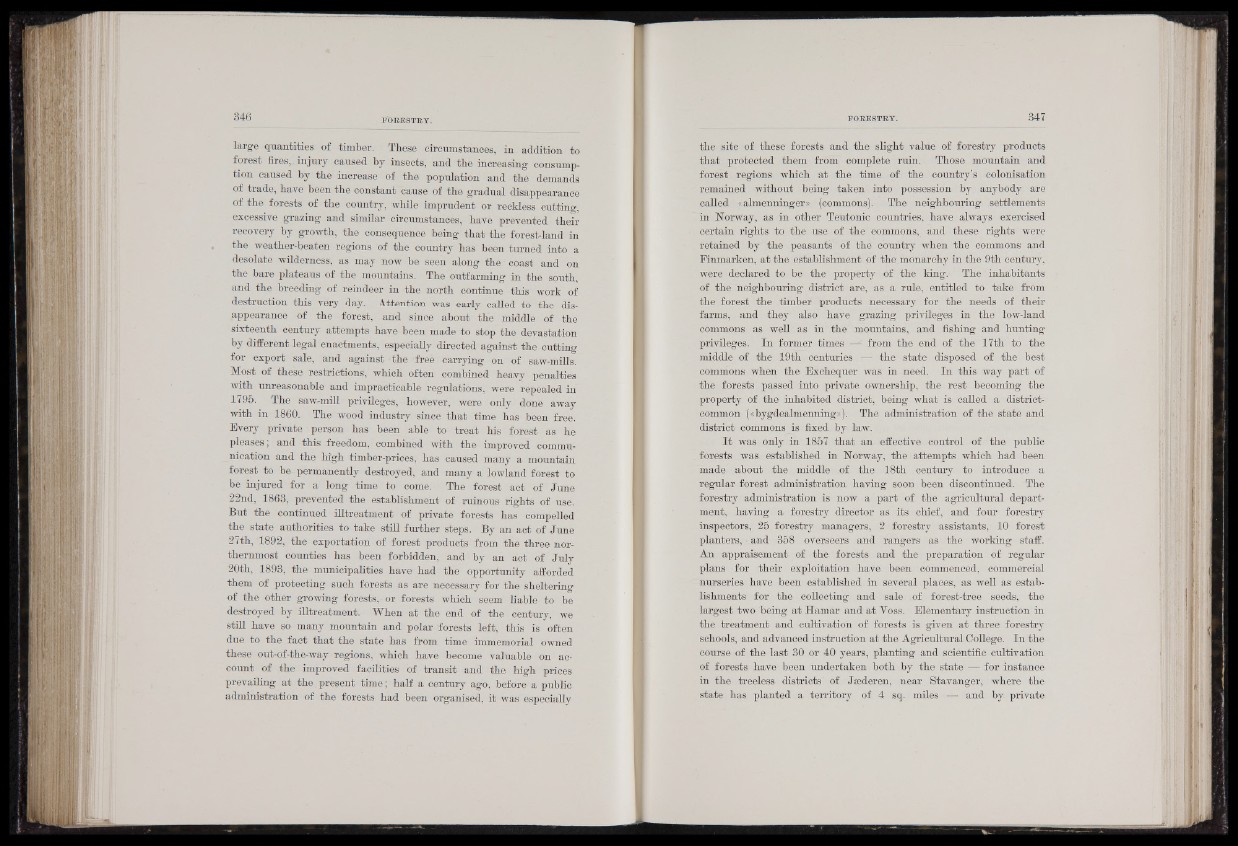
large quantities of timber. These circumstances, in addition to
forest fires, injury caused by insects, and the increasing consumption
caused by the increase of the population and the demands
of trade, have been the constant cause of the gradual disappearance
of the forests of the country, while imprudent or reckless cutting,
excessive grazing and similar circumstances, have prevented their
recovery by growth, the consequence being that the forest-land in
the weather-beaten regions of the country has been turned into a
desolate wilderness, as may now be seen along the coast and on
the bare plateaus of the mountains. The outfarming in the south,
and the breeding of reindeer in the north continue this work of
destruction this very day. Attention was early called to the disappearance
of the forest, and since about the middle of the
sixteenth century attempts have been made to stop the devastation
by different legal enactments, especially directed against the cutting
for export sale, and against the free carrying on of saw-mills.
Most of these restrictions, which often combined heavy penalties
with unreasonable and impracticable regulations, were repealed in
1796. The saw-mill privileges, however, were only done away
with in 1860. The wood industry since that time has been free.
Every private person has been able to treat his forest as he
pleases; and this freedom, combined with the improved communication
and the high timber-prices, has caused many a mountain
forest to be permanently destroyed, and many a lowland forest to
be injured for a long time to come. The forest act of June
22nd, 1863, prevented the establishment of ruinous rights of use.
But the continued illtreatment of private forests has compelled
the state authorities to take still further steps. By an act of June
27th, 1892, the exportation of forest products from the three northernmost
counties has been forbidden, and by an act of July
20th, 1893, the municipalities have had the opportunity afforded
them of protecting such forests as are necessary for the sheltering
of the other growing forests, or forests which seem liable to be
destroyed by illtreatment. When at the end of the century, we
still have so many mountain and polar forests left, this is often
due to the fact that the state has from time immemorial owned
these out-of-the-way regions, which have become valuable on account
of the improved facilities of transit and the high prices
prevailing at the present time; half a century ago, before a public
administration of the forests had been organised, it was especially
the site of these forests and the slight value of forestry products
that protected them from complete ruin. Those mountain and
forest regions which at the time of the country’s colonisation
remained without being taken into possession by. anybody are
called «almenninger» (commons). The neighbouring settlements
in Norway, as in other Teutonic countries, have always exercised
certain rights to the use of the commons, and these rights were
retained by the peasants ' of the country when the commons and
Einmarken, at the establishment of the monarchy in the 9th century,
were declared to be the property of the king.- The inhabitants
of the neighbouring district are, as a rule, entitled to take from
the forest the timber products necessary for the needs of their
farms, and they also have grazing privileges in the low-land
commons as well as in the mountains, and fishing and hunting
privileges. In former times B 9 from the end of the 17th to the
middle of the 19th centuries ^ 9 the state disposed of the best
commons when the Exchequer was in need. In this way part of
the forests passed into private ownership, the rest becoming the
property of the inhabited district, being what is called a district-
common («bygdealmenning»). The administration of the state and
district commons is fixed by law.
I t was only in 1857 that an effective control of the public
forests was established in Norway, the attempts which had been
made about the middle of the 18th century to introduce a
regular forest administration having soon been discontinued. The
forestry administration is now a part of the agricultural department,
having a forestry director as its chief, and four forestry
inspectors, 26 forestry managers, 2 forestry assistants, 10 forest
planters, • and 358 overseers and rangers as the working staff.
An appraisement of the forests and the preparation of regular
plans for their exploitation have been commenced, commercial
nurseries have been established in several places, as well as establishments
for the collecting and : sale of forest-tree seeds, the
largest two being at Hamar and at Yoss. Elementary instruction in
the treatment and cultivation of forests is given at three forestry
schools, and advanced instruction at the Agricultural College. In the
course of the last 30 or 40 years, planting and scientific cultivation
of forests have been undertaken both by the state — for instance
in the treeless districts of Jæderen, near Stavanger, where the
state has planted a territory of 4 sq. miles — and by. private